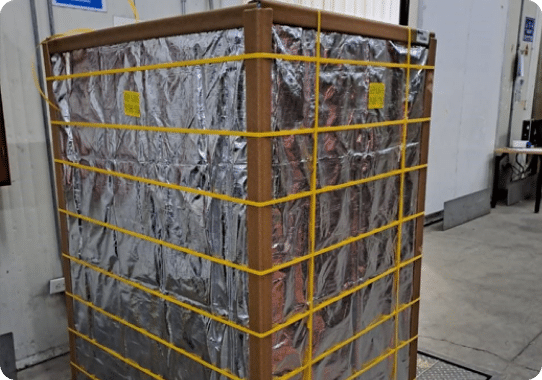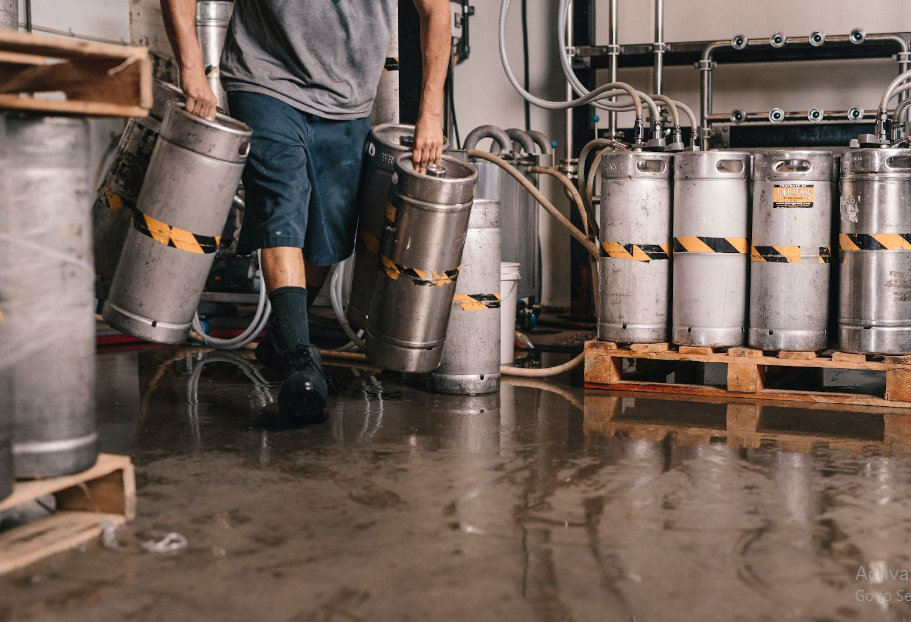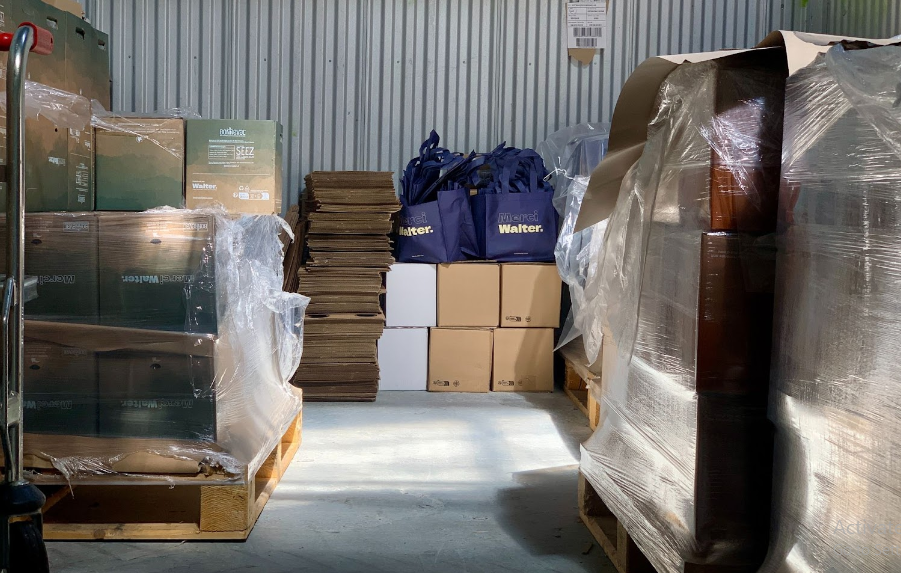
Protecting your cargo is key, especially if you’re shipping something that’s sensitive to moisture, temperature changes and other environmental factors. Making sure cargo arrives safely at its destination is one of the most important aspects of logistics, and it involves a lot of equipment and expertise.
Thermal pallet covers are one of the things shipping companies like EPGNA use to protect shipments during transit. A good pallet blanket can also help you protect pallets throughout the supply chain, so you don’t have to worry about accidentally damaging expensive inventory.
If you have temperature-sensitive inventory or cargo, you need to have thermal covers you can count on. A quality insulated pallet cover can protect you from massive financial losses, so you don’t want to skimp when it comes to supply chain management. Find out how EPGNA’s custom solutions can help you protect your goods through every stage of the supply chain.
Thermal pallet covers are covers that you can place over a fully loaded pallet to protect your goods. These pallet covers are designed for easy installation, so they’re easy to take on and off in just a few minutes. You may also hear a thermal pallet cover referred to as an insulated pallet cover, pallet blanket or thermal shipping blanket.
There are several types of pallet covers and liners that can help you protect your cargo, but thermal pallet covers are specially designed to protect cargo from extreme temperatures. When you’re shipping containers full of cargo across the world, extreme weather can be a major obstacle. When your pallets are sitting on a boat or in a truck on a hot summer day in a warmer region, thermal pallet covers keep them from getting too hot.
So, why do you need a thermal pallet blanket for your cargo? The answer is simple: a lot of cargo is sensitive to extreme temperatures. Extremely hot or cold temperatures can damage lots of different cargo, including food and beverages and chemical-based products. Damaged cargo costs you money, and thermal shipping blankets are an affordable and effective way to protect your cargo from temperature changes.
One great thing about thermal pallet covers is that they’re simply designed and easy to use. Thermal pallet covers are basically blankets that consist of an outer shell with insulation on the inside. You can find different outer shell materials, but polyester is pretty common. Some thermal pallet covers, like our Temcore thermal pallet cover, combine insulation with a reflective outer shell, providing extra protection against extreme heat. Velcro attachments give you a way to secure your pallet blanket to make sure it stays on for as long as you need it to.
Thermal pallet covers are used by shipping companies like EPGNA as well as business owners. Pallet covers are a key part of safely shipping stuff that’s sensitive to extreme temperatures, but they can also be used in the warehouse. If you have a warehouse full of chemical-based products or pharmaceuticals, you can use an insulated pallet cover to extend shelf life and prevent inventory loss.
Another nice feature of thermal pallet covers is the fact that they’re reusable. Some temperature-sensitive shipping solutions can be expensive because you have to buy dry ice and other materials every time you need to ship something. Once you have a handful of pallet covers, you can reuse them for several years. That being said, thermal pallet covers need basic maintenance if you want them to last.

Thermal pallet covers aren’t just for shipping cold products; there are lots of things that are sensitive to extreme cold or heat. If your business ships goods that can’t handle extreme temperatures, you need pallet covers.
The pharmaceutical industry relies on thermal pallet covers because pharmaceuticals are usually temperature-sensitive. Extreme temperatures can affect the active ingredients that make medicine work, which makes medicine less effective and causes dangerous side effects in some cases. Since pharmaceutical companies can lose a lot of money if a pallet of medicine is compromised, they use pallet covers all the time.
Pallet covers are also used to protect food and beverages, so you can use them for your restaurant or restaurant supply store. You don’t have to deal with ice cream and other frozen goods to use pallet covers. Things like fruits and vegetables and bottled and jarred foods can also be protected with thermal cargo blankets. Even bottled water and cans of soda should be stored in a relatively cool area with no direct sunlight to maintain quality.
Storing chemicals at safe temperatures isn’t just a matter of protecting your bottom line. Combustible chemicals and other temperature-sensitive chemicals can pose serious risks if they’re stored in extreme heat or direct sunlight. When you’re storing any type of chemical, make sure you’re storing it somewhere safe.
You can also use thermal shipping blankets to keep electronics from getting damaged in the warehouse or during the shipping process. Things like smartphones, TVs and computers are made from lots of small parts, many of which are made of or contain metal. These metal parts — including batteries — can melt and compromise electronics if they’re exposed to extreme heat. Pallet covers can also help keep dirt and dust away from electronics, adding an extra layer of protection.
There are several other industries where thermal cargo blankets are commonly used. If you have temperature-sensitive cargo or inventory, you can protect it by covering it up.

There are several different types of thermal pallet covers to choose from, and finding the right covers for your cargo can be overwhelming. Looking at the pros and cons of each option is the best way to make a smart decision. In this section, we’ll talk about three popular types of thermal pallet covers.
Polyethylene thermal pallet covers are made of insulation wrapped in a polyethylene (plastic) shell. The shell helps protect the insulation and extend the life of your pallet covers, but it doesn’t provide extra insulation like some materials do.
The biggest benefit of polyethylene pallet covers is the price point. These are the simplest pallet covers, so they’re an affordable option if you need basic protection. The downside is that polyethylene isn’t a very insulative material, so it doesn’t add much insulation. Still, polyethylene is a great choice if you’re looking for something cheap and durable.
Polypropylene covers are essentially the same thing as polyethylene, only they’re made from a different type of plastic. Compared to polyethylene, polypropylene thermal pallet covers offer better insulation at a higher price point.
There’s no substantial difference between polyethylene and polypropylene aside from the insulation quality. Both materials are flexible and durable, which makes them long-lasting and easy to deal with. If you want a good middle-ground option, polypropylene is a solid choice.
PVC thermal pallet covers aren’t quite as common as other materials because they’re more expensive, but they’re one of the best options in terms of quality.
A good PVC pallet cover will provide some of the best insulation you can find. Of all the plastic materials, PVC is the most insulative. PVC thermal pallet covers are also more expensive than polyethylene and polypropylene, but you get what you pay for. PVC does an excellent job of absorbing heat so your cargo isn’t exposed to extreme temperatures.
Unlike plastic-based thermal pallet covers that absorb and reflect heat, aluminum pallet covers reflect heat. This unique design makes aluminum pallet covers the most effective option if you need premium insulation.
Aluminum pallet covers have a silver reflective shell on the outside that reflects most of the heat. Plastic-based pallet covers, on the other hand, reflect a portion of the heat and absorb the rest. The aluminum shell is wrapped around a layer of insulation, so you get the benefits of insulation and reflection all in one.
You may have to pay a little more for reflective thermal pallet covers, but they’re the best money can buy.
Before you start shopping for pallet covers, you need to know what to look for. There are lots of little features you can focus on when you’re shopping for thermal pallet covers. Check out some of the most popular features below to learn how to shop for insulated pallet covers.
The thickness or weight of a thermal pallet cover is one of the biggest features to consider. Materials have a lot to do with insulation and heat reflection, but you need enough insulation to protect your cargo.
Cheap pallet covers can be a fraction of a millimeter thick, while high-quality thermal pallet covers are usually a few millimeters thick. That extra space allows for more insulation, which protects your goods from extreme weather. You don’t need the thickest pallet covers if you’re just looking for moderate heat protection, but it’s better to be safe than sorry.
We talked about some of the popular thermal pallet cover materials earlier, including polyethylene, polypropylene, PVC and aluminum. Figure out which material is right for you to make sure you’re getting a good pallet cover.
If price isn’t an obstacle, PVC and aluminum are the best choices in terms of insulation. Aluminum is the best choice because it combines insulative and reflective properties to give you the best protection against heat. If you’re shipping particularly sensitive goods like food, chemicals or pharmaceuticals, aluminum pallet covers are the way to go.
Different types of pallet covers use different materials for insulation, so that’s something to consider. The fill material that provides insulation is also available in different weights which has a major effect on insulation quality.
Fiber-fill insulation is the most popular option, but it’s available in a range of weights. Insulation weights are measured in the number of grams per square meter, or grams/m2. 150 grams/m2 is considered lighter insulation, while 450 grams/m2 is on the heavier side.
Keep in mind that a lot of thermal pallet covers don’t actually list the insulation fill weight. You can reach out to the manufacturer if you’re having trouble finding a listed weight.
Thermal pallet covers are so popular because they’re easy to use, so look for something that’s not too heavy or bulky so it’s easy to set up and maintain.
Most thermal pallet covers are essentially blankets that you can drape over the top of your pallets, which means they’re easy to install. Some pallet covers have plastic sleeves so you have a place to put documents and shipping info.
If you go with an affordable plastic thermal pallet cover, it may even be machine-washable. This isn’t an essential feature, but it’s a nice added bonus.
No matter what you do, make sure you’re buying a thermal pallet cover with velcro attachments. Velcro attachments make it easy to securely attach each corner of your pallet cover, so you don’t have to worry about it sliding around or coming loose during shipping.
You can also look for a thermal pallet cover with zipper closures. Zippers and velcro help you securely seal pallet covers to maximize protection.
Using your thermal pallet cover is simple, but there are a few tips you can use to get the best results.
Before you get started, make sure everything you’re covering is securely packaged and in place. Food and beverages should be securely sealed to keep dirt and pests out. Wrapping your pallet in plastic helps you keep stacks of boxes and other products from tipping over. If you want, you can use shrink wrap over the top of your pallet cover.
Start by choosing a pallet cover that’s properly sized for the pallet you’re covering up. You can drape your pallet cover over the top of the pallet to make sure it fits. Once you’ve got your pallet cover draped over the pallet with an even amount of overhang on each side, you can use the zippers or velcro to securely attach each corner. Now your pallets are ready to be safely stored or shipped.
When it’s time to unload pallets, all you have to do is undo the velcro or zippers in the corners and remove the cover. Clean your pallet cover off once it’s removed and store it somewhere safe so you can use it again.
Thermal pallet covers aren’t the only type of pallet covers; there are several products that help you protect your cargo.
At EPGNA, we’re dedicated to developing the best solutions for your container shipping needs. Whether you’re shipping perishable goods like fruits and vegetables or sensitive items like medication or medical samples, EPGNA offers several thermal pallet cover options.
The Temcore cover is the ideal all-around solution when it comes to thermal pallet covers. Our Temcore cover offers protection against moderate fluctuations in temperature, so you can protect individual pallets of mildly temperature-sensitive goods. These covers are easy to install and completely encase pallets, providing protection from every angle. Temcore covers are also a great long-term temperature stabilization solution because they’re reusable.
Our Temcore Max cover is the upgraded version of our standard Temcore cover. If you’re looking for protection against extreme fluctuations in temperature, this is the pallet cover you want. The Temcore Max cover is capable of maintaining stable temperatures within +/- 1 degree F per hour, making it the best option for particularly sensitive cargo like medication and food.
Thermal pallet covers are one way to maintain stable cargo temperatures, but we offer a wide range of existing and custom temperature stabilization solutions at EPGNA.
If you want to maintain stable temperatures all throughout your shipping container, you can install a Temcore container liner. Container liners are designed to completely cover the inside of your shipping container to create a thermal barrier that protects against extreme heat. Since our container liners form a complete seal inside your shipping container, they also protect against contamination.
For non-conventional cargo where a thermal pallet cover doesn’t work, our Temcore thermal blankets are a good alternative. Thermal blankets are designed to be draped over the top of your cargo to reflect heat and stabilize cargo temperatures. You can find thermal blankets in several sizes, and you can reach out to us if you need a custom size.
Supply chain management is crucial when you’re dealing with temperature-sensitive goods, and using thermal pallet covers is just the beginning.
When you’re dealing with temperature-sensitive goods, you need people who know how to handle them. Every employee should be trained to handle temperature-sensitive inventory, and you should choose a shipping provider that has the expertise and equipment to safely ship your products.
Packaging is a huge part of protecting temperature-sensitive goods. You can find several packing materials that provide extra protection for your cargo, and there are even insulated boxes and shipping bags. When you’re packaging temperature-sensitive cargo, pick a box that’s big enough to fit the insulation and other packing materials you need to protect your package.
You should also consider your shipping route when you’re transporting temperature-sensitive cargo. If you’re shipping temperature-sensitive food and medication thousands of miles, consider the climates your cargo is going to travel through. In some cases, it may be better to choose a longer route that provides less exposure to extreme temperatures.
You can combine various temperature stabilization solutions for the best results. Start by using packaging that’s designed to protect against extreme temperatures, then decide where you want to go from there. For mildly sensitive cargo, a basic thermal pallet cover should get the job done. For extremely sensitive cargo, you may want to go with our Temcore Max cover — or combine thermal pallet covers with an insulated container liner.
Understanding temperature-sensitive supply chain management is vital if your business deals in food and beverages, pharmaceuticals, electronics or any other temperature-sensitive goods. Thermal pallet covers are an excellent way to protect your cargo during every step of the supply chain.
Temcore covers from EPGNA are designed with a reflective outer material, so you get the benefits of reflection and insulation in one cover. Temcore Max covers keep temperatures to within 1 degree per hour. When you need to ship cargo that’s sensitive to extreme temperatures, EPGNA has you covered. Contact us today to learn more about Temcore covers and get a free quote.

Sandra Malouf is the President of Eurolog Packing Group and has spent her career focused on Industrial Packaging. With a proven track record of helping businesses avoid supply chain disruptions, Sandra’s visionary leadership elevates the industry. She’s committed to developing sustainable practices and continues to shape the future of industrial packaging by listening to the customer and offering unique solutions applicable to various industries across the world. The company’s main focus is temperature stabilization and moisture damage prevention in exports affected by extreme variations in global temperatures.
© 2025 Eurolog Packing Group